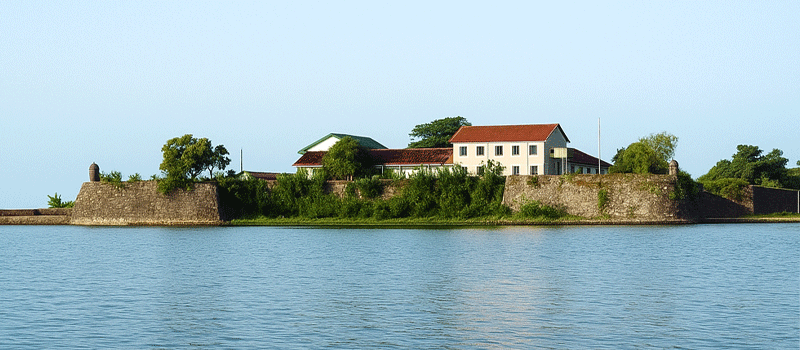Located on the small island of Puliyanthivu in Sri Lanka’s Eastern Province, Batticaloa Fort showcases centuries of colonial rule and represents the region’s rich and complex history. It is one of the most beautiful and well-preserved colonial forts in the country, with ancient walls and bastions that overlook the calm Batticaloa Lagoon. Originally built as a Portuguese stronghold, the fort changed hands among colonial powers, leaving behind a unique mix of architectural styles and a story of strategic significance and resilience.
The Fort’s History
The story of Batticaloa Fort starts in 1628 when the Portuguese built it as a trading and administrative center. Its location on an island surrounded by the lagoon and a canal made it a natural defensive structure and a key hub for controlling trade in the area. The Portuguese faced threats from the powerful Kandyan Kingdom and the rising Dutch, which highlighted the need for a fortified settlement in the east.
However, the Portuguese control of the fort was short-lived. In 1638, the Dutch, with help from King Rajasinghe II of Kandy, captured the fort to drive out the Portuguese. Initially, the Dutch destroyed the fort, seeing it as unnecessary for their plans. But its strategic importance soon became clear, and by 1665, they began rebuilding it, completing the reconstruction by 1682. The current structure, featuring four massive bastions, mainly results from this Dutch reconstruction. The Dutch operated the fort as a crucial administrative and trading post for nearly two hundred years, focusing on goods like cinnamon and pepper.
The British were the last colonial power to control the fort. They captured it from the Dutch in 1796. Under British rule, the fort continued to be an important administrative center. They repurposed many buildings within the fort for their needs, using it as a prison and a rest house. This long history of occupation by various European powers has added layers of architectural and cultural influences to the fort.
Architectural Features and Significance
The architecture of Batticaloa Fort is a captivating mix of European military engineering. The fort is a four-sided structure, often described as resembling a four-pointed star, and is mainly made of granite and coral. Its thick, strong walls were designed for defense, standing about 2.7 meters high. The fort is shielded by the Batticaloa Lagoon on two sides and a water-filled moat on the others, creating a strong barrier against attacks.
The most striking features are the four bastions, located at each corner of the fort. These bastions, strengthened by the Dutch, offered a lookout point for observation and defense. Remnants of the fort’s past, including old cannons and other colonial artifacts, are scattered around the grounds, providing a tangible link to its military history.
Inside the fort, visitors will find a variety of colonial-era buildings. While many have been altered over the years, they still serve a purpose today, housing several government departments. This unusual situation—where an ancient fort is also an active administrative hub—allows visitors to experience a living piece of history. A ruined bell tower and the remains of an old church further emphasize its colonial past.
Beyond its military and administrative importance, the fort area has an even older history. Archaeological findings suggest that an ancient Buddhist stupa existed on this site, dating back to the 1st century B.C. from the Ruhuna Kingdom. This indicates the site held religious significance long before European powers arrived, making it a place where ancient Sri Lankan history and colonial heritage meet.
The Fort Today: A Tourist Spot and Cultural Center
Today, Batticaloa Fort is a popular tourist destination and a central point for the local community. While it continues to function as a government office complex, visitors are encouraged to explore its grounds, walk along the ramparts, and enjoy the sweeping views of the Batticaloa Lagoon and the city. The fort’s location is a major appeal, offering stunning vistas and a peaceful atmosphere.
Plans are underway to further develop the fort as a tourism and cultural center. The government aims to move the administrative offices to fully open the space to the public and support historical preservation. This initiative seeks to restore the fort to its former glory and turn it into a hub for heritage interpretation, cultural events, and community activities.
A visit to Batticaloa Fort allows you to step back in time and discover a site that has witnessed centuries of change. It’s more than just a collection of old buildings; it is a living story of Sri Lanka’s colonial journey, its strategic importance, and its rich cultural heritage. The fort stands as a silent observer, sharing tales of trade, conflict, and the coexistence of diverse communities that have shaped the Eastern Province.
Exploring the fort offers a rewarding experience for history enthusiasts and casual visitors alike. It’s an opportunity to connect with the past and appreciate the many influences that have shaped Sri Lanka into the nation it is today.

